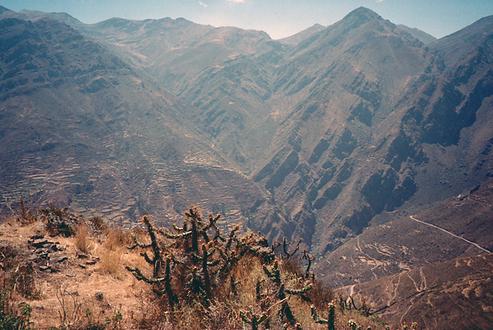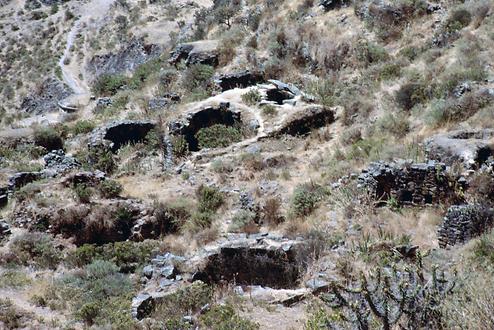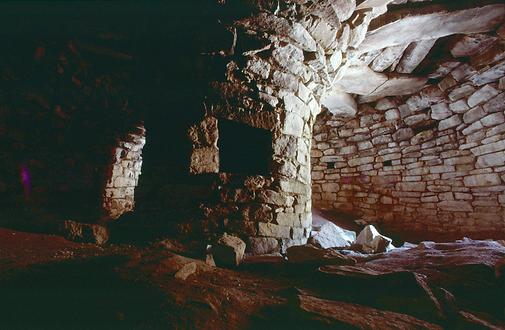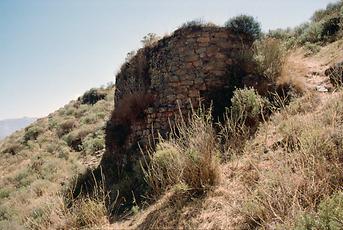An Axis Between Heaven and Earth#
Peru, Canta Marca#
All photos were taken by the author and are subject to copyright.
At the end of a long journey I am always reluctant to arrive early at the airport of departure from a far-away location. Bus strikes, road blocks caused by storms and problems caused by illness can lead to straits in time. In New York, in 1968, I would have missed my return flight to Vienna sitting in a taxi from Manhattan to the John F. Kennedy Airport, if the aircraft had not taken off badly delayed due to technical problems.
Since then I usually go to the airport very timely and on longer journeys I also try to be in the respective city one or two days before my departure. Usually, I am pre-planning a programme for the days prior to the return flight in the vicinity of such a city. When I planned another trip to Peru in 2003, I remembered that there are quite some Inca and Pre-Inca ruins nearby that I did not know yet. Geoge Kubler had documented some of them in several sketches in his book 'The art and architecture of ancient America: the Mexican, Maya, and Andean Peoples', 1962.

Photo: H. Hohmann, under CC BY-SA 4.0
At the end of my trip in 2003 I arrived in Lima two days before my departure. At my instigation a staff member of the hotel asked several bus companies, when and where from a bus was leaving the next day to Canta. So I took a taxi the next morning at 6:45 am from Miraflores across huge and foggy Lima to the bus terminal from where I was to go to Canta.
Fortunately, the inhabitants of this city are generally no early birds and so there were no major traffic jams at this time of the day. I arrived at the site near the outward road to the north well before my departure time. No one was waiting for the bus there and so the taxi driver asked some passers-by if this really was the starting-point for the bus to Canta. Apart from a number of useless answers, it soon became clear that the starting-point had been transferred two blocks.
So we went to the new starting-point and there was a woman with her child and luggage already waiting for the bus. I paid the taxi driver and positioned myself next to her. Actually, the bus was to leave five minutes later. Instead of more passengers a heavyset man with a self-important attitude in a black leather jacket arrived after the scheduled departure time. He telephoned on and on, apparently also with a bus driver. Then he spoke to us and said that there were too few passengers and we would soon be picked up by a minibus, but would have to change into a bigger bus soon after. This took up another half an hour. Then this already fulled-up bigger bus drove us through the northern suburbs of Lima towards Cerro de Pasco - the final stop of this bus, on whose route also Canta is located. Seemingly endless and with some changes of direction we drove through an elongated valley subtly upwards. Small villages and fields with irrigation systems on widespread terraced fields accompanied us along the road. Now and then the bus stopped to pick up someone or let someone else get off. It was already 12 o'clock when the main road left the bottom of the valley to lead slightly meandering uphill. We finally reached a small elevation with the town of Canta. The bus had a short halt. The passengers went for something to eat or drink. Then the bus drove on to Cerro de Pasco, a town at an altitude of 4330 m and with a mining site as deep as 250 m, staggered down in endless terraces. It lies already on the other side of the Andean main ridge. I stopped in Canta.
A height measurement in Canta resulted in 2845 m above sea level, This did surprised me, as I had not noticed the incline at all. But I could have guessed because of the more pleasant climate. The drop between Lima and Canta is considerable. The ruins of Canta Marca were said to be nearby. On the map they were drawn right next to the small town. Therefore, I asked several people about the ruins, but nobody seemed to know them. The first one who seemed to know about them took me by the hand, drew me to the middle of the road, and pointed almost vertically up to the top of a high mountain nearby, which was yet another 1000 m higher. I asked several taxi drivers if there was a road up there. One of them said that he knew a road to a former stone quarry close to the ruins and from where there were still about 500 m of altitude to be surmounted, thus the half the height difference. We agreed on a reasonable price including the waiting time.
And yet I found myself on a winding and sparsely gravel road with little traffic. It was laid out for heavy vehicles, but was no longer in use and had many washed out sections. At a particular point where the terrain became somewhat flatter and green vegetation gave a pleasant climate, the taxi stopped. The driver turned and showed the way up. He lay down comfortably on the grass in the shade. I put on my hat and applied a sun blocker on my arms and nose.

Photo: H. Hohmann, under CC BY-SA 4.0

Photo: H. Hohmann, under CC BY-SA 4.0
Then I headed off uphill. The path was open and could be walked on without any problems. It took me about an hour to get to the top. Up there was a circular open space with a small new chapel. But nothing to see of the ruins. I made another determination of the position and a height measurement - I was at 3810 m above sea level. As I looked down the mountain on the north-east side, I discovered some ruins hardly noticable in the bushes.

Photo: H. Hohmann, under CC BY-SA 4.0

Photo: H. Hohmann, under CC BY-SA 4.0

Photo: H. Hohmann, under CC BY-SA 4.0

Photo: H. Hohmann, under CC BY-SA 4.0

Photo: H. Hohmann, under CC BY-SA 4.0

Photo: H. Hohmann, under CC BY-SA 4.0

Photo: H. Hohmann, under CC BY-SA 4.0
So I walked down on the other side again for a while and came to a round building with a very low, narrow entrance. Meanwhile I had cut off a dry and reasonably unbowed branch from a bush with my knife and freed it from its smaller branches to use it as a walking aid. I left it here at the entrance and crawled on all fours into the building trusting that I would not encounter a snake. Inside I saw a relatively high vault built around a round pillar in the center. The pillar was hollow inside, had two staggered openings into the room and acted as a link between top and bottom. But there were no stairs.
The vegetation consisted of very hard thorny shrubbery which can be found mainly in the spaces between buildings and the ruins of collapsed buildings. The bushes seem to protect themselves behind such windbreaks from the sometimes harsh weather conditions. This is one reason why the buildings are so hard to see. There are snakes and a kind of hares that find their way through the shrubbery.
I then visited another largely intact building in which, unlike in the first, the central pillar stood on a square basis. There was only one entrance to the hollow interior of it. Close to the outer walls, the vault had a circular shape but a square shape next to the pillar in the center so that the capstones must have different lengths.
The interior of another building was not round, but oval with an eccentric, also angular and hollow pillar. This building clearly showed a ground floor and an upper floor. The dead were buried on ground floor, the rooms on the upper floor were reserved for the gods. Therefore, the buildings allegorizes the religious conception of the world along a vertical axis - the gods live on top, the people on earth, and the deceased below them. The constructions were built between 1100 and 1450 AD. The longer I stayed in this area with its ruins, the more buildings became visible to me. There were also a few rectangle buildings in the relatively steep slope north of this mountaintop. All buildings had, as far as they were still existing and therefore could be examined, stone roofs according to the principle of corbelling, i.e. resting on some kind of support.
Although it was an extensive archaeological site with mostly interesting round buildings different from the buildings of the Inca civilization, very seldom somebody came to this mountain so close to Lima in 2003. Also, the panoramic view is spectacular. With my walking stick I climbed down from the mountain quite quickly and reached the taxi, whose driver was now lying in the sun and sound asleep, sweating terribly. By this time it had already become 4.00 pm. Back to Canta I paid the driver and waited for the next bus which luckily arrived soon. In the meantime I ate some biscuits with jam I had brought with me from Lima to lighten my luggage and mainly to still my hunger which I had suppressed during my visit. Then I went back to Lima by the bus which also came back from Cerro de Pasco. The bus ride finnished deep in the night. A taxi brought me back through the city to Miraflores.